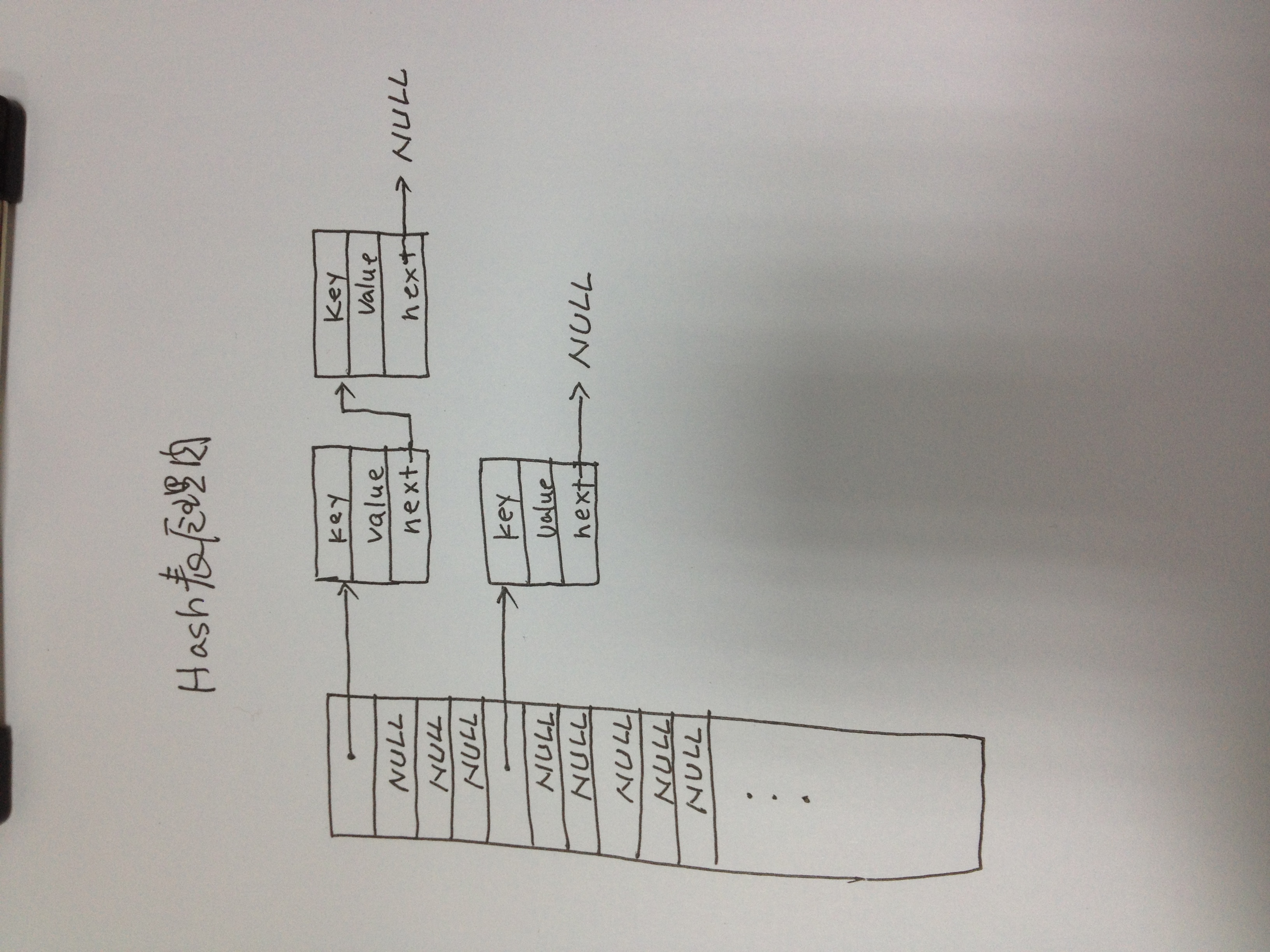1 哈希表原理
这里不讲高深理论,只说直观感受。哈希表的目的就是为了根据数据的部分内容(关键字),直接计算出存放完整数据的内存地址。
试想一下,如果从链表中根据关键字查找一个元素,那么就需要遍历才能得到这个元素的内存地址,如果链表长度很大,查找就需要更多的时间.
void* list_find_by_key(list,key)
{
for(p=list;p!=NULL; p=p->next){
if(p->key == key){
return p;
}
return p;
}
}为了解决根据关键字快速找到元素的存放地址,哈希表应运而生。它通过某种算法(哈希函数)直接根据关键字计算出元素的存放地址,由于无需遍历,所以效率很高。
void* hash_table_find_by_key(table, key)
{
void* p = hash(key);
return p;
}当然,上面的伪代码忽略了一个重要的事实:那就是不同的关键字可能产生出同样的hash值。
hash("张三") = 23;
hash("李四") = 30;
hash("王五") = 23;这种情况称为“冲突”,为了解决这个问题,有两种方法:一是链式扩展;二是开放寻址。这里只讲第一种:链式扩展。
也就是把具有相同hash值的元素放到一起,形成一个链表。这样在插入和寻找数据的时候就需要进一步判断。
void* hash_table_find_by_key(table, key)
{
void* list = hash(key);
return list_find_by_key(list, key);
}需要注意的是,只要hash函数合适,这里的链表通常都长度不大,所以查找效率依然很高。
下图是一个哈希表运行时内存布局:
2 纯C实现源码
实际工作中,大多数情况下,关键字都是字符串的形式,而大多数教科书上却使用整数关键字来举例,这非常脱离实际。为此,本人决定使用纯C语言开发一个哈希表结构,供大家参考。主要特点:
- 基于接口开发,对外彻底隐藏实现细节
- 具有自动释放客户结构内存的回调功能
- 采用经典的Times33哈希算法
- 采用纯C开发,可供C和C++客户使用
HashTable.h 头文件
#pragma once
typedef struct HashTable HashTable;
#ifdef __cplusplus
extern "C" {
#endif
/* new an instance of HashTable */
HashTable* hash_table_new();
/*
delete an instance of HashTable,
all values are removed auotmatically.
*/
void hash_table_delete(HashTable* ht);
/*
add or update a value to ht,
free_value(if not NULL) is called automatically when the value is removed.
return 0 if success, -1 if error occurred.
*/
#define hash_table_put(ht,key,value) hash_table_put2(ht,key,value,NULL);
int hash_table_put2(HashTable* ht, char* key, void* value, void(*free_value)(void*));
/* get a value indexed by key, return NULL if not found. */
void* hash_table_get(HashTable* ht, char* key);
/* remove a value indexed by key */
void hash_table_rm(HashTable* ht, char* key);
#ifdef __cplusplus
}
#endifHashTable.c 实现文件
#include "HashTable.h"
#include <stdlib.h>
#include <string.h>
#include <stdio.h>
#define TABLE_SIZE (1024*1024)
/* element of the hash table's chain list */
struct kv
{
struct kv* next;
char* key;
void* value;
void(*free_value)(void*);
};
/* HashTable */
struct HashTable
{
struct kv ** table;
};
/* constructor of struct kv */
static void init_kv(struct kv* kv)
{
kv->next = NULL;
kv->key = NULL;
kv->value = NULL;
kv->free_value = NULL;
}
/* destructor of struct kv */
static void free_kv(struct kv* kv)
{
if (kv) {
if (kv->free_value) {
kv->free_value(kv->value);
}
free(kv->key);
kv->key = NULL;
free(kv);
}
}
/* the classic Times33 hash function */
static unsigned int hash_33(char* key)
{
unsigned int hash = 0;
while (*key) {
hash = (hash << 5) + hash + *key++;
}
return hash;
}
/* new a HashTable instance */
HashTable* hash_table_new()
{
HashTable* ht = malloc(sizeof(HashTable));
if (NULL == ht) {
hash_table_delete(ht);
return NULL;
}
ht->table = malloc(sizeof(struct kv*) * TABLE_SIZE);
if (NULL == ht->table) {
hash_table_delete(ht);
return NULL;
}
memset(ht->table, 0, sizeof(struct kv*) * TABLE_SIZE);
return ht;
}
/* delete a HashTable instance */
void hash_table_delete(HashTable* ht)
{
if (ht) {
if (ht->table) {
int i = 0;
for (i = 0; i<TABLE_SIZE; i++) {
struct kv* p = ht->table[i];
struct kv* q = NULL;
while (p) {
q = p->next;
free_kv(p);
p = q;
}
}
free(ht->table);
ht->table = NULL;
}
free(ht);
}
}
/* insert or update a value indexed by key */
int hash_table_put2(HashTable* ht, char* key, void* value, void(*free_value)(void*))
{
int i = hash_33(key) % TABLE_SIZE;
struct kv* p = ht->table[i];
struct kv* prep = p;
while (p) { /* if key is already stroed, update its value */
if (strcmp(p->key, key) == 0) {
if (p->free_value) {
p->free_value(p->value);
}
p->value = value;
p->free_value = free_value;
break;
}
prep = p;
p = p->next;
}
if (p == NULL) {/* if key has not been stored, then add it */
char* kstr = malloc(strlen(key) + 1);
if (kstr == NULL) {
return -1;
}
struct kv * kv = malloc(sizeof(struct kv));
if (NULL == kv) {
free(kstr);
kstr = NULL;
return -1;
}
init_kv(kv);
kv->next = NULL;
strcpy(kstr, key);
kv->key = kstr;
kv->value = value;
kv->free_value = free_value;
if (prep == NULL) {
ht->table[i] = kv;
}
else {
prep->next = kv;
}
}
return 0;
}
/* get a value indexed by key */
void* hash_table_get(HashTable* ht, char* key)
{
int i = hash_33(key) % TABLE_SIZE;
struct kv* p = ht->table[i];
while (p) {
if (strcmp(key, p->key) == 0) {
return p->value;
}
p = p->next;
}
return NULL;
}
/* remove a value indexed by key */
void hash_table_rm(HashTable* ht, char* key)
{
int i = hash_33(key) % TABLE_SIZE;
struct kv* p = ht->table[i];
struct kv* prep = p;
while (p) {
if (strcmp(key, p->key) == 0) {
free_kv(p);
if (p == prep) {
ht->table[i] = NULL;
}
else {
prep->next = p->next;
}
}
prep = p;
p = p->next;
}
}3 测试程序
下面是测试程序源码,基于C++。
测试程序test.cpp
#include <stdio.h>
#include <stdlib.h>
#include "HashTable.h"
// 要放入哈希表中的结构体
struct Student
{
int age;
float score;
char name[32];
char data[1024 * 1024* 10];
};
// 结构体内存释放函数
static void free_student(void* stu)
{
free(stu);
}
// 显示学生信息的函数
static void show_student(struct Student* p)
{
printf("姓名:%s, 年龄:%d, 学分:%.2f\n", p->name, p->age, p->score);
}
int main()
{
// 新建一个HashTable实例
HashTable* ht = hash_table_new();
if (NULL == ht) {
return -1;
}
// 向哈希表中加入多个学生结构体
for (int i = 0; i < 100; i++) {
struct Student * stu = (struct Student*)malloc(sizeof(struct Student));
stu->age = 18 + rand()%5;
stu->score = 50.0f + rand() % 100;
sprintf(stu->name, "同学%d", i);
hash_table_put2(ht, stu->name, stu, free_student);
}
// 根据学生姓名查找学生结构
for (int i = 0; i < 100; i++) {
char name[32];
sprintf(name, "同学%d", i);
struct Student * stu = (struct Student*)hash_table_get(ht, name);
show_student(stu);
}
// 销毁哈希表实例
hash_table_delete(ht);
return 0;
}